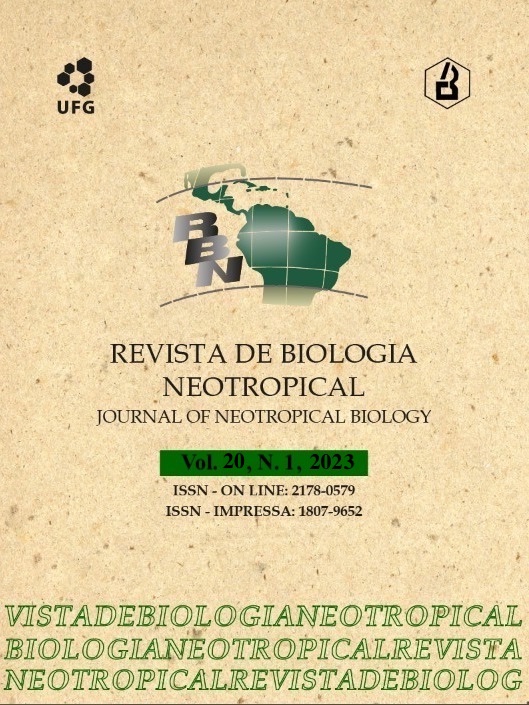Frost damage in a Lobelia brasiliensis population at Reserva Ecológica do IBGE, Brasília – Federal District, Brazil
Keywords:
rare plant, endangered species, Cerrado, frostAbstract
Lobelia brasiliensis A. O. S. Vieira & G. J. Shepherd is a rare and endemic plant of the Federal District (DF), present in the Ecological Reserve of the Brazilian Institute of Geography and Statistics (IBGE), located in the south-central portion of the DF, in the center of the Cerrado biome. Low temperatures can impose restrictions on Cerrado vegetation. In May 2022, the temperature dropped sharply in the DF, reaching a minimum temperature of 2°C in the Reserve. Seeking to evaluate the effects of frost on the population of L. brasiliensis, a field survey was carried out in the area two months after the mentioned climatic event, and a second survey four months later. For one hour, three people walked about 1,300 m along the area, covering approximately 1 ha. A total of 84 individuals of L. brasiliensis were located in the field, ranging from single rosettes with about 20 cm in diameter to individuals with multiple rosettes forming patches of approximately 2 m in diameter. All individuals had dry leaves and stems. However, all individuals were already in an advanced stage of regrowth, with several new leaves. Thus, although the low temperature event affected individuals, there is still no evidence of permanent damage to the population.
Downloads
References
Antonio, A. C. D. 2019. Respostas ecofisiológicas de plantas arbóreas do cerrado à geada. Dissertação de Mestrado, Universidade Estadual Paulista, Rio Claro.
Brando, P. M. & G. Durigan. 2005. Changes in cerrado vegetation after disturbance by frost (São Paulo State, Brazil). Plant Ecol. 175: 205-215. DOI: https://doi.org/10.1007/s11258-005-0014-z
Dias, B. F. S. 1992. Cerrados: uma caracterização. pp. 11-25. In: Dias, B. F. S. (Coord.). Alternativas de desenvolvimento dos cerrados: manejo e conservação dos recursos naturais renováveis. Brasília, IBAMA & FUNATURA.
Eiten, G. 1972. The cerrado vegetation of Brazil. Bot. Rev. 38: 201-341. DOI: https://doi.org/10.1007/BF02859158
Filgueiras, T. S. & B. A. S. Pereira. 1989. Efeito de uma geada sobre a flora do cerrado na Reserva Ecológica do IBGE, DF-Brasil. Cadernos de Geociências. 2: 67.
Franco, A. C. & J. C. Álvarez‐Yépiz. 2022. Editor’s Highlight: Adaptive responses of tropical savanna trees to frost. Trees. 36: 1-5. DOI: https://doi.org/10.1007/s00468-021-02164-1
Freitas, L., L. Moraes, D. Kutschenko & T. Serrano. 2014. Campanulaceae. pp. 82-83. In: Martinelli, G., T. Messina & L. Santos Filho (Eds.). Livro vermelho da flora do Brasil: plantas raras do Cerrado. Rio de Janeiro, Andrea Jakobsson, Instituto de Pesquisas Jardim Botânico do Rio de Janeiro, CNCFlora.
Hoffmann, W. A., S. W. Flake, R. C. R. Abreu, N. A. Pilon, D. R. Rossatto & G. D. Durigan. 2019. Rare Frost Events Reinforce the Distribution of Tropical Biomes. J. Ecol. 107: 468-477. DOI: https://doi.org/10.1111/1365-2745.13047
IUCN. 2012. IUCN Red List Categories and Criteria: Version 3.1. Second edition. IUCN, Gland, Switzerland and Cambridge, UK. Available in: <https://www.iucnredlist.org/resources/categories-and-criteria>. Access on 23 sep. 2022.
Kruckeberg, A. R. & D. Rabinowitz. 1985. Biological Aspects of Endemism in Higher Plants. Ann. Rev. Ecol. Syst. 16: 447-479. DOI: https://doi.org/10.1146/annurev.es.16.110185.002311
Meirelles, M. L., L. C. Oliveira, J. L. Vivaldi, A. R. Santos & J. R. Correia. 2002. Espécies do estrato herbáceo e profundidade do lençol freático em áreas úmidas do cerrado. Planaltina, DF, Embrapa Cerrados.
Meirelles, M. L., A. J. M. Guimarães, R. C. Oliveira, G. M. Araújo & J. F. Ribeiro. 2004. Impactos sobre o estrato herbáceo de Áreas Úmidas do Cerrado. pp. 41-68. In: Aguiar, L. M. S. & A. J. A. Camargo (Eds.). Cerrado: ecologia e caracterização. Planaltina, Embrapa Cerrados.
Nonato, V. S. B. 2022. Outono de 2022: Veja como foi a estação nas capitais: Brasília (DF), Goiânia (GO), Cuiabá (MT), Palmas (TO) e Porto Velho (RO). Avalaible in: <https://portal.inmet.gov.br/noticias/balan%C3%A7o-do-outono-de-2022-nas-capitais-bras%C3%ADlia-df-goi%C3%A2nia-go-cuiab%C3%A1-mt-palmas-to-e-porto-velho-ro>. Access on 18 jun. 2022.
Pereira, B. A. S. & P. P. Furtado. 2011. Vegetação da bacia do córrego Taquara: coberturas naturais e antrópicas. pp. 88-117. In: Ribeiro, M. L. (Org.). Reserva Ecológica do IBGE: Biodiversidade Terrestre. v. 1. Rio de Janeiro, IBGE.
Ribeiro, M. L. 2011. Reserva Ecológica do IBGE: Biodiversidade Terrestre. Rio de Janeiro, IBGE.
Santos, F. F. M. & C. B. R. Munhoz. 2012. Diversidade de espécies herbáceo-arbustivas e zonação florística em uma Vereda no Distrito Federal. Heringeriana. 6: 21-27.
Silberbauer-Gottsberger I., W. Morawetz & G. Gottsberger. 1977. Frost damage of cerrado plants in Botucatu, Brazil, as related to the geographical distribution of the species. Biotropica. 253-261.
Silva, F. A. M., E. D. Assad & B. A. Evangelista. 2008. Caracterização Climática do Bioma Cerrado. pp. 69-88. In: Sano, S. M., S. D. Almeida & J. F. Ribeiro (Eds.). Cerrado: Ecologia e Flora. Brasília, DF, Embrapa Informação Tecnológica.
Vieira, A. O. S. & G. J. Shepherd. 1998. A new species of Lobelia (Campanulaceae) from Brazil. Novon. 457-460.
Zanatta, M. R. V. 2012. Plantas raras e ameaçadas do Distrito Federal, Brasil. Dissertação de Mestrado, Universidade de Brasília.
Downloads
Published
How to Cite
Issue
Section
License
Copyright (c) 2023 Revista de Biologia Neotropical / Journal of Neotropical Biology

This work is licensed under a Creative Commons Attribution-NonCommercial 4.0 International License.
The expontaneos submmition of the manuscript automaticaly implies in the cession of all patrimonial rights for the Journal of Neotropical Bilogy (RBN) after publication. The autor allow the right of first publication of the article to the RBN, under Creative Commons Attribution 4.0 (CC BY-NC 4.0) Licence.
There are garanties for the authors to the authorial and moral rights, for each one of the articles published by RBN, with permissions:
1. The use of article and contents for the education and researches.
2. The use of the article and their contents, linking to the Article on the web site of the RBN, allowing the divulgation on:
- institutional closed web (intranet).
- open access repositories.
3. Preparation and divulgation of the other publication derived from the article and its content, if there is citation of the original publication by RBN.
4. Make printed copies in small quatinties for personal use.

















